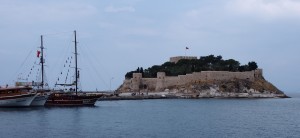 Turkey is quite a big country within Europe, with a population close to 80 million. 18 million of whom live in Istanbul, which despite its popularity is not the capital of Turkey. Turkey is quite odd because it spans two different continents. 3% of Turkey is in Europe, a region referred to as Thrace and 97% is in Asia, referred to as Anatolia.
Turkey is quite a big country within Europe, with a population close to 80 million. 18 million of whom live in Istanbul, which despite its popularity is not the capital of Turkey. Turkey is quite odd because it spans two different continents. 3% of Turkey is in Europe, a region referred to as Thrace and 97% is in Asia, referred to as Anatolia.
For me personally Turkey had three main destinations I wanted to visit: Istanbul, Pamukkale and Cappadocia. I will talk about Cappadocia and Istanbul in coming posts, but for now I would like to talk about the coastal town Kusadasi and its nearby highlights.
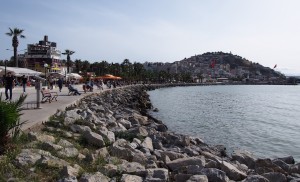 Kusadasi
Kusadasi
Kusadasi is a major tourist port on the coast of the Aegean Sea. It regularly has multiple cruise ships in port. Because of this the town is incredibly touristy, very expensive and for me, it wasn’t that pleasant a place to be. The major draw card of Kusadasi is its proximity to some other places.
The House of the Virgin Mary
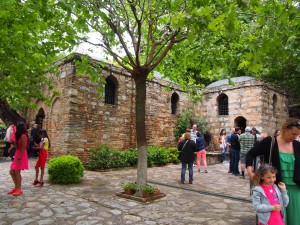 In the 19th century a Roman Catholic nun, Blessed Anne Catherine Emmerich had visions of the house of the Virgin Mary, describing its location and its appearance. The visions were recorded author Clemens Brentano. Some time later a French priest discovered a house near the Aegean Sea that matched the exact description Mary’s house as recorded by Brentano. Despite the question of authenticity, many people make the pilgrimage to the house. Many people also take the water from the natural springs nearby to use as holy water, with the belief it has some spiritual and healing properties. There is also a wishing wall where people write their wish on a piece of paper and tie it to the wishing wall. It was quite an interesting site to visit, and it certainly has a great deal of history.
In the 19th century a Roman Catholic nun, Blessed Anne Catherine Emmerich had visions of the house of the Virgin Mary, describing its location and its appearance. The visions were recorded author Clemens Brentano. Some time later a French priest discovered a house near the Aegean Sea that matched the exact description Mary’s house as recorded by Brentano. Despite the question of authenticity, many people make the pilgrimage to the house. Many people also take the water from the natural springs nearby to use as holy water, with the belief it has some spiritual and healing properties. There is also a wishing wall where people write their wish on a piece of paper and tie it to the wishing wall. It was quite an interesting site to visit, and it certainly has a great deal of history.
Ephesus
 Near to the House of the Virgin Mary is the ancient city of Ephesus. It was built around 6000BC and experienced many different regimes throughout its existence. When looking at the architecture and construction these regimes are visible. As an example, the red brickwork is from the Byzantine period; marble from the Roman period and grey stone from the Greek period.
Near to the House of the Virgin Mary is the ancient city of Ephesus. It was built around 6000BC and experienced many different regimes throughout its existence. When looking at the architecture and construction these regimes are visible. As an example, the red brickwork is from the Byzantine period; marble from the Roman period and grey stone from the Greek period.
I’m not the most knowledgeable on history, but I must say it was a very old site and while I might not have retained must of the history I was provided, I did find it a fascinating place.
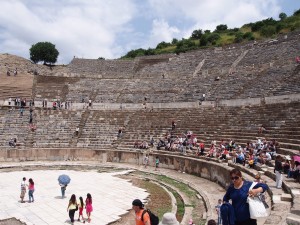 The city was enormous and very spread out. I think that without deviating much from the main path, it was over a kilometer walking from one end to the other. There were two amphitheaters, the smaller one up the hill and the larger towards the bottom of the site. The larger one was used for bigger events, including gladiator and animal fights. Nearby this amphitheater was the gymnasium, where the gladiators trained in fitness, strength and fighting skills.
The city was enormous and very spread out. I think that without deviating much from the main path, it was over a kilometer walking from one end to the other. There were two amphitheaters, the smaller one up the hill and the larger towards the bottom of the site. The larger one was used for bigger events, including gladiator and animal fights. Nearby this amphitheater was the gymnasium, where the gladiators trained in fitness, strength and fighting skills.
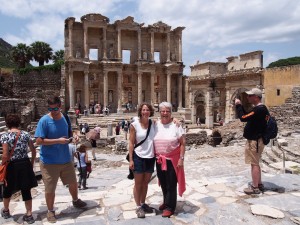 Based on the size of the amphitheater, and other factors I’m sure, archeologists have determined that the ancient city had a population of roughly 250,000. Of those 200,000 were locals and 50,000 were slaves. My two favourite structures in the city were the temple of Hadrian and the Library; they are both gorgeous structures and have lots of fine detail in the carvings.
Based on the size of the amphitheater, and other factors I’m sure, archeologists have determined that the ancient city had a population of roughly 250,000. Of those 200,000 were locals and 50,000 were slaves. My two favourite structures in the city were the temple of Hadrian and the Library; they are both gorgeous structures and have lots of fine detail in the carvings.
Temple of Artemis
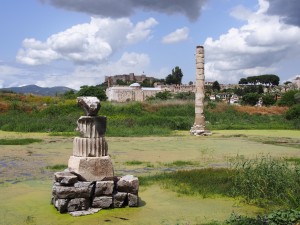 The goddess Artemis was considered the goddess of fertility in Roman times. A temple was created and dedicated to her, the Temple of Artemis, which is one of the Seven Wonders of the Ancient World.
The goddess Artemis was considered the goddess of fertility in Roman times. A temple was created and dedicated to her, the Temple of Artemis, which is one of the Seven Wonders of the Ancient World.
It was originally a grand structure with 127 columns, but now only one remains together with some small parts of the foundations.
Pamukkale
 The name Pamukkale translates to Cotton Castle. The region got this name because of the high volume of calcium carbonate in the water, which has created a white ‘castle’ on the hillside, with hot springs and travertines. The castle used to be pristine white, but due to its popularity many people used to visit, hotels were built on the site, people used to walk on the area and even ride motorbikes over the area. Thankfully UNESCO has since protected it and site access is fairly heavily restricted. If you want to walk down to the travertines and swim in the small pools you must walk barefoot.
The name Pamukkale translates to Cotton Castle. The region got this name because of the high volume of calcium carbonate in the water, which has created a white ‘castle’ on the hillside, with hot springs and travertines. The castle used to be pristine white, but due to its popularity many people used to visit, hotels were built on the site, people used to walk on the area and even ride motorbikes over the area. Thankfully UNESCO has since protected it and site access is fairly heavily restricted. If you want to walk down to the travertines and swim in the small pools you must walk barefoot.
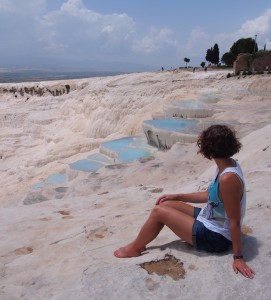 The ancient city of Hierapolis was actually built on the hillside above the castle, and many opt to visit this city as well as the white castle. For me, the only thing that had my attention was the travertines. The white castle covers a large area and is approximately 2,700 metres long, 600 metres wide and 160 metres high. Of this, most of the travertines are dried up, but there is one very small portion that remains. Small, tiered, pristine white terraces containing vivid aqua-blue water that are just stunning to see. Battling the hordes of tourists was worth it to see this amazing natural wonder.
The ancient city of Hierapolis was actually built on the hillside above the castle, and many opt to visit this city as well as the white castle. For me, the only thing that had my attention was the travertines. The white castle covers a large area and is approximately 2,700 metres long, 600 metres wide and 160 metres high. Of this, most of the travertines are dried up, but there is one very small portion that remains. Small, tiered, pristine white terraces containing vivid aqua-blue water that are just stunning to see. Battling the hordes of tourists was worth it to see this amazing natural wonder.

